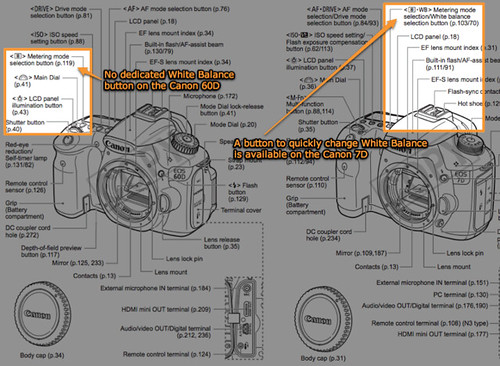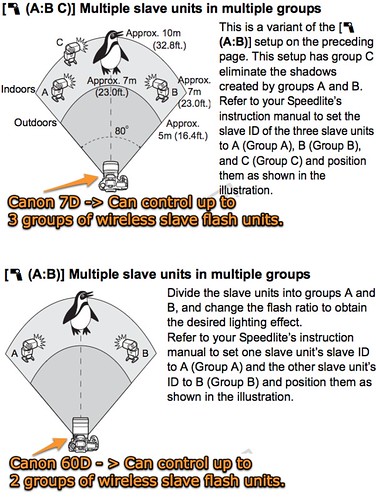In this post, I attempt to compare and summarize the pros and cons, and differences between these two digital SLR cameras from Canon and hopefully, this will help those deciding whether to get the 7D or 60D.
For a quick side-by-side comparison of both cameras, see this page on DPReview.
Canon 60D Advantages
Smaller, and lighter
If you plan on doing lots of hiking or traveling where you might want to keep the weight of your photographic equipment to an absolute minimum, then the 60D is the logical choice as it is about 302 g / 10.65 oz / 0.67 lb lighter than the 7D.
Let’s look at some relevant figures.
- Weight, including batteries: Canon 60D — 520 g (18.3 oz) Canon 7D — 822 g (29 oz)
- Dimensions Canon 60D — Approx. 5.69 x 4.17 x 3.09 in. / 144.5 x 105.8 x 78.6mm Canon 7D — Approx. 5.8 x 4.4 x 2.9 in. / 148.2 x 110.7 x 73.5mm
Polycarbonate plastic-over-metal construction is used for the 60D and while subjectively, this doesn’t give the same solid feel as you’d get with the Canon 7D, you’ll get to enjoy significant savings in weight.
Articulating LCD
This makes it much easier to shoot video and photos with the camera held at waist level, or with the camera close to the ground or held high above your head.
But you mentioned family video and because of this need I would recommend the 60D because of the flip out screen that will allow you to see the LCD monitor from many different positions. It will allow you to capture video without breaking your back trying to position yourself directly behind the camera all the time. The flip out LCD will be very handy for getting video of kids without having to get on your knees all the time and get many more interesting angles, and that’s why your going to buy a 60D.
Lower in Price
At $999, the 60D is almost $600 cheaper than the $1,599 7D (prices are correct at the time of writing — please check Canon 60D Price, In-Stock and Availability Watch and Canon 7D Price Watch and Availability for updates).
For those on a rather more restricted budget, this means you’ll have money left over for cheap, quality lenses such as the Canon EF 50mm f/1.8 II, Canon EF 50mm f1.4 USM or Canon EF 85mm f/1.8 USM. Alternatively, you could consider buying an external flash such as the Canon 270EX, 430EX II or 580 EX II.
Given a fixed amount of funds, it’s generally wiser to purchase quality lenses and accessories which give you more “image quality bang for the buck” compared to splurging on a more expensive camera.
In-camera RAW Editing
With the 60D, you have the option of processing normal, full-sized RAW files into JPEG pictures right in the camera. Although the breadth of options and, on closer scrutiny, the conversion quality, will not be at par with what you’d get using a full-blown RAW conversion utility (for instance, Adobe Photoshop, Adobe Lightroom, Apple’s Aperture or Canon Digital Photo Professional) on your computer, this convenience is nice to have while on the field.
Pages 226 and 227 of the Canon 60D Manual has details on the type of parameters available to you. Some examples of processing options you can change are Brightness, White Balance and High ISO Speed Noise Reduction.
In-camera Post-Processing
The 60D allows you to apply a variety of digital “Creative Filters” such as Grainy B/W, Soft Focus, Toy Camera Effect and Miniature Effect to images that you’ve captured with the camera.
You are also able to create smaller-sized copies of images in the camera.
This feature is convenient for the times that you’re not near your computer and wish to quickly create variations of the images on the 60D’s memory card.
Audio Recording Level Adjustment
On the 7D, the sound recording level is automatically adjusted while you’re shooting a movie clip.
With the 60D, you get to select one of 64 sound recording levels, in addition to [Auto]matic and [Disable] options. There is also an option to enable or disable the Wind Filter setting.
Highest ISO Speed for Auto ISO
On the 60D, you’re able to set the maximum ISO value the camera will go up to in Automatic ISO mode.
You can choose specific values in the ISO 400 to 6400 range. This lets you prioritize between better image quality with less noise or avoid using a slow shutter speed.
Canon 7D Advantages
More Buttons, Dials and Custom Settings
If you’re frequently shooting in situations which demand that you be able to change camera settings quickly and easily, the 7D is the camera for you.
One example is changing the White Balance. On the 7D, you do this by pressing a button and selecting your desired value by turning the rear dial. On the 60D, you’d have to dive into the menus and navigate to the appropriate tab to select a new white balance value.
Another example is flash exposure compensation, which is a button press and a dial rotation away on the 7D, while you’ll need to dive into the menus on the 60D to effect the same adjustment.
You also get to store and quickly recall up to three sets of custom settings on the 7D, compared to 2 sets on the 60D.
Plus, dual Digic 4 processors makes the 7D an overall winner in terms of speed of operation, making the super-responsive 7D the better option for sports, wildlife and action photography where frequent changes to the camera’s internal configuration is required.
Superior AF system
All of the 7D’s 19 autofocus points are cross-type and well-positioned, while the 60D only has 9 cross-type AF points. Having more AF points lets you track of moving targets more effectively, as there’s a higher chance of having at least one AF point trained on the subject.
Faster burst rate
The 7D is rated at 8 fps (frames per second) compared to 5.3 fps on the 60D. If you shoot lots of action or sports photography where high frame rates is paramount, or even want to capture as many frames within the shortest interval of time possible, then the 7D is your camera.
Better continuous JPEG shot buffer depth
The 7D has a larger memory buffer for JPEG images, being able to store 126 JPEGs (when using UDMA / Ultra DMA CF cards) or 15 RAW files in one continuous burst, while the 60D only manages 58 JPG files, but does have a slight upper hand in the RAW department, being able to capture 16 RAW files in one burst.
This is a huge difference in JPEG buffer performance, something that is significant if you shoot a lot of JPG photos in quick succession, say at weddings, sports or any other event where the action is thick and fast and you don’t want to miss shots.
AF micro-adjust
This is needed to correct front or back-focusing (in other words, automatic focusing errors) you might experience with certain lenses. Tack sharp images are guaranteed once the required adjustment is dialed in. This feature is not available on the 60D, which means that you will have to send the camera and the Canon lens in question to a Canon service center for focus calibration.
Push-start video recording
A dedicated external push button on the 7D lets you start shooting movie clips easier and faster than doing the same with a twist of the command dial on the 60D.
Build quality
If you care about build quality, the 7D will feel more solid and substantial owing to its magnesium alloy construction. The rugged 7D also has better weather sealing, which should make for a more robust protection against dust and the elements.
Bear in mind that there have been no official tests to measure the actual hardiness of either camera. This benefit relates more to the perceived feel of the camera rather than any actual metric. Both cameras should be more than capable of holding up to the regular usage patterns of most photographers.
Grids and 100% Viewfinder Coverage
Viewfinder coverage is 100% on the 7D, and 96% on the 60D. Photo.net has a good discussion on why 100% viewfinders are nice — B M Mills writes:
… there are times when 100% would be nice. When shooting through fences for example, or around other tricky obstacles, there have been times when I’ve thought my shot was clear but in fact the object I was trying to avoid popped up in a corner of the end image.
Additionally, the 7D has an option to display a grid overlay in the optical viewfinder to help with keeping horizons straight while you compose your shot. The 60D has this feature only in Live View mode, where the grid is displayed on the rear LCD screen.
PC Sync Port
This gives you connection and trigger capabilities with legacy flash systems, if you’re not already into using wireless sync devices such as Pocket Wizards.
Spot AF Points
When turned on, you’ll be able to enjoy manual AF selection of focus points that cover a much smaller area (when compared to single-point AF), thus giving you pinpoint accuracy for photographing macros or small objects.
Wireless Flash Control
The Canon 7D allows you to control up to three separate groups of wireless remote flash units, compared to only two separate groups in the case of the 60D.
For more details, refer to the section on using wireless flash in the Canon 7D Manual, which starts on page 119.
Professionals who specialize in flash photography will appreciate this benefit offered by the 7D.
Conclusion
The Canon 7D, short of having a nice vary-angle LCD, is the better bet for the photographer looking for a camera that offers total creative freedom. The range of features, functionality and capabilities in this incredible piece of technology ensures that professional photographers and aspiring pros will not be held back when trying to get that all-important shot in the field.
Don’t forget to first write your priorities down before researching either camera. If possible, try both in a store to get a feel of which fits your hands better. Very often, the camera that works best in your hands is the camera you will end up with, assuming both cameras have very similar capabilities, which is true in the case of the Canon 7D and 60D.
Ultimately, be assured that both cameras give you images with extremely high image quality. Choose the 7D if you shoot lots of action photography or frequently require quick access to all settings and parameters. Choose the 60D if your style of photography is unhurried and if you appreciate the choice of audio levels while shooting movies and additional flexibility offered by the rotating LCD.
Related
Canon 60D – Main page.
Canon 7D – Main page.



